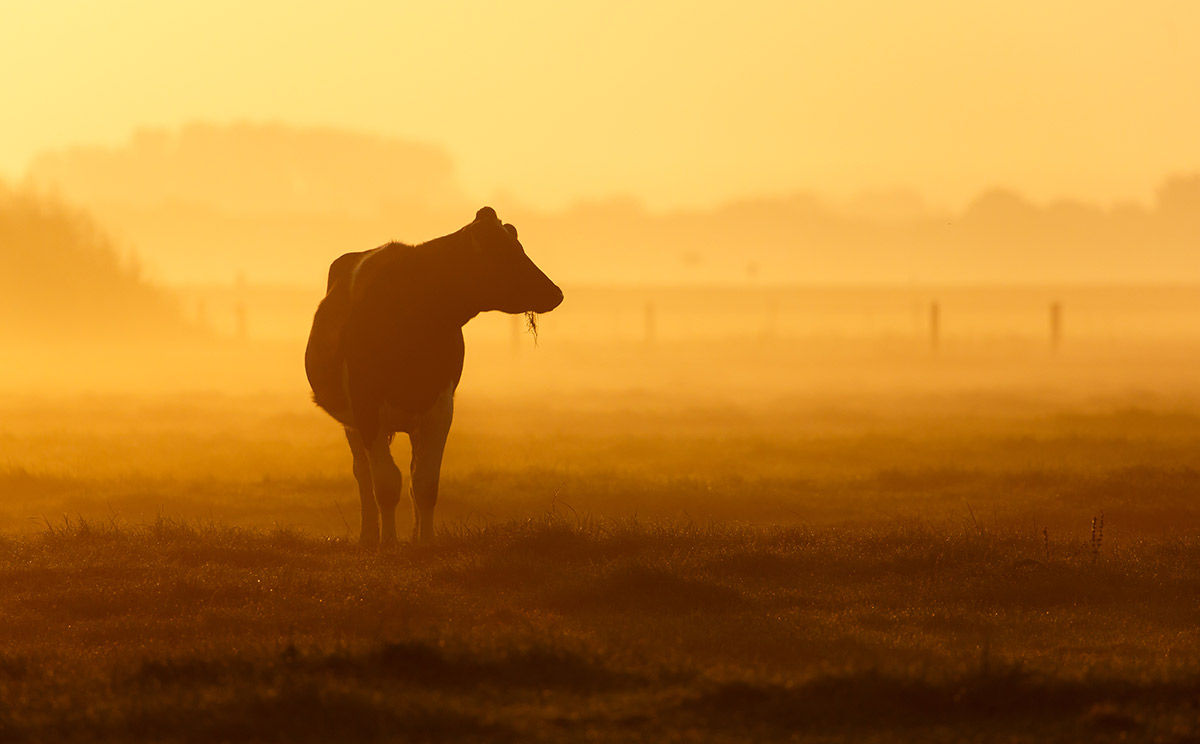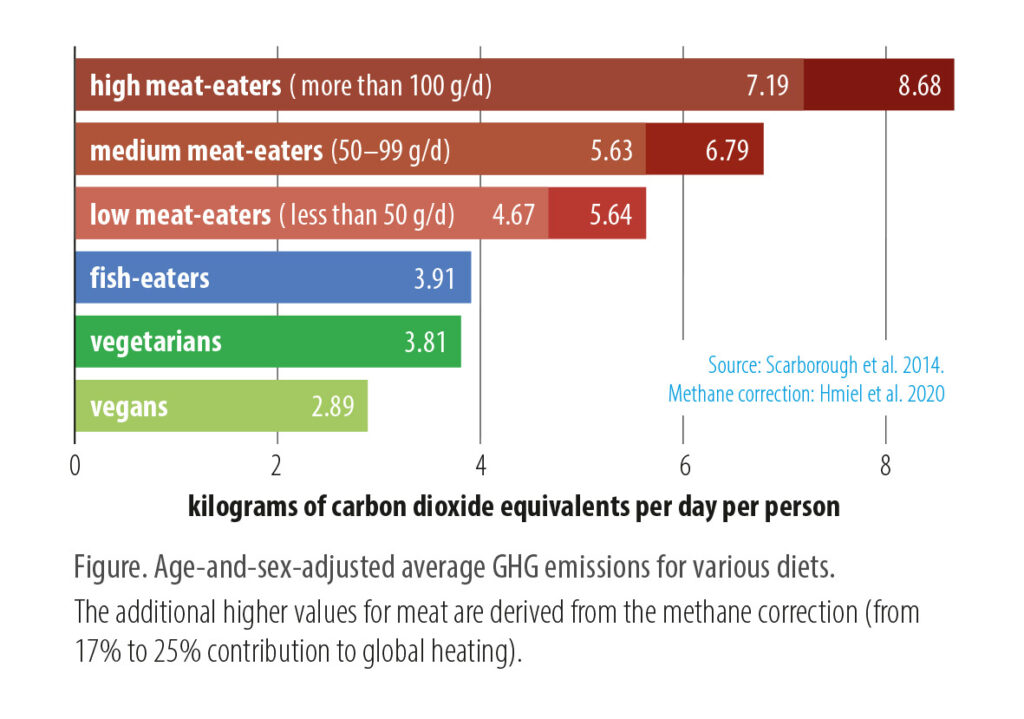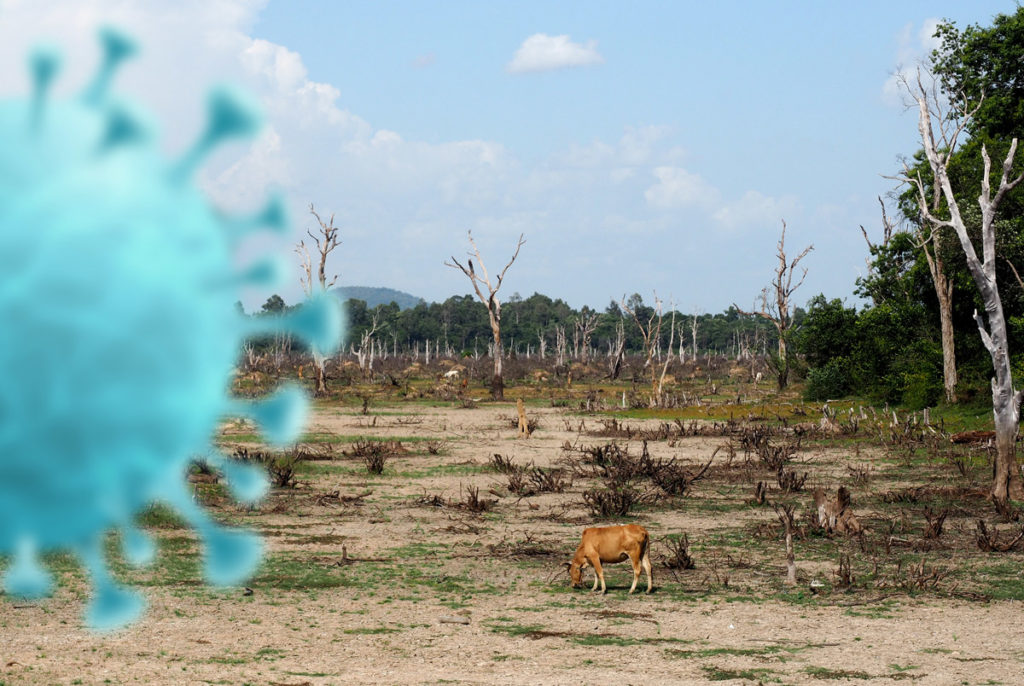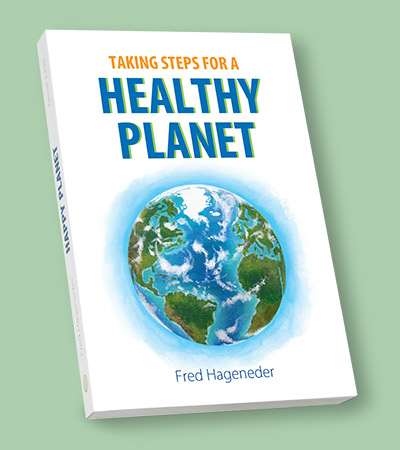Livestock
LIVESTOCK, CORONA AND CLIMATE

Cattle breeding even more damaging to the climate than car traffic
29 June 2020
Factory farming and industrial abattoirs are ideal breeding grounds for germs of all kinds; it is no coincidence that they play such a major role in the corona crisis. Moreover, high meat consumption has been completely unethical for decades: about one eighth of humanity is threatened by starvation, while the wealthiest eighth claims over 80% of all cultivated land in the world to satiate its desire for animal meat. This article deals with land grabbing and the enormous climate damage caused by intensive animal husbandry.
At first glance, transport appears to be the bigger source of GHG emissions – for example, about 29% in the USA, and 26% in the UK,[1] while agriculture is usually listed at under 10% or a maximum of 14%. Hence, many people disregard it as a ridiculous idea that cattle should be a significant climate factor at all. Transportation emissions are a multiple of those from livestock, or are they?
Such numbers may describe the situation in industrial countries, whose agricultural sector is deceptively underrepresented in the GHG discussion because of their high net imports of food and feed. Europe in particular has long outgrown its physical carrying capacity and for a large part lives on agricultural imports. Not even half of the total agricultural and forestry output that Europe consumes or exports is produced on land located within Europe: 53% of European land use is being virtually imported, mainly from Brazil, Russia, and China.[2] To tackle the global ecological crisis we cannot stop at national datasets. In the planetary flux of substances there are no national borders. Hence we need to look at global, not national data. Because the “rest” of the world drives fewer cars but grows more food and animal feed than the industrialized countries (but also for them), the global balance is quite different to that of industrial nations.
The next major misconception is that in many statistics and graphs, the sector “change of land use” is attributed to forestry, which, however, requires comparatively little (fossil) energy. “Change of land use” largely is a euphemism for the destruction of forest and other natural areas (usually by fire) and their subsequent conversion for the agricultural industry, mainly into pastures or monocultures for animal feed or palm oil. The consequent integration of Change of Land Use into the agricultural sector of GHG emissions shifts the proportions significantly.*
* For example, according to the World Resources Institute: [3] traffic 16.2% (of which road transport 11.9%, air, rail, ship and other 4.3%), agriculture 12.9% (CO2 from energy use 1.7%; CH4 + N2O: soils 4.1%, livestock & manure 5.8%, rice cultivation 1.3%), and deforestation aka “Change of land use” 20.8% of global GHG emissions.
And the climate damage of burning forests is not just the carbon released by the fire, but the carbon which the trees won’t absorb in the following years because they have been replaced by pasture, soy fields or palm oil plantations. Plus: Burning forests are a major source of nitrous oxide, a GHG around 300 times more potent than CO2. If tropical rainforest loss was a country it would rank third in global GHG emissions, after China and the US, in other words: tropical rainforest destruction produces more GHG emissions than the burning of fossil fuel in all of Europe.[4] This increases the responsibility for agriculture and livestock significantly.
The third widespread misconception is to focus on CO2 alone. This greenwashes cows because cars undoubtedly emit more CO2, and less methane. Only a quarter of the GHG emissions from livestock are CO2.
Total global CO2 emissions: about 36 Gt = billion metric tons (in 2016, [5] and 37.2 Gt in 2019) [5]
But the total GHG emissions need to include the other gases that accelerate global heating, namely methane and nitrous oxide. They are calculated in carbon dioxide equivalent (CO2e):
total global GHG emissions: 49.4 Gt CO2e (2016) [6]
In this more honest scenario, the impact of transportation comes down to 16.2% (air, rail, ship & other 4.3%, road transport 11.9%) of all GHG emissions, while the impact of cows trebles:
total global GHG emissions from livestock: 7.1 Gt of Co2e = 14.5% (2016)
Cattle (beef and milk) represents about two thirds of the livestock sector’s emissions (9.4%), and cars and vans constitute about two thirds of road traffic emissions (8%). Therefore, among livestock, cattle alone are worse for the climate than cars. And this is not the end of the calculation, there is more to consider:
What even the UN Food & Agriculture Organisation (FAO) doesn’t seem to account for in this calculation is GHG from soil degradation. The soils of the world are also a huge carbon reserve, the top metre alone contains three times as much carbon as the entire atmosphere. But due to soil degradation caused by farming practices, 133 Gt of carbon have been lost from the top two metres of the world’s soil since the dawn of agriculture. This figure is known as the total “soil carbon debt”, and represents a mean loss of 8% of the original carbon reserve, according to research published in the Proceedings of the National Academy of Sciences.[7] Some of this carbon lost through intensive agriculture is captured again by vegetation in other places, but most of it escapes into the atmosphere. This shows how tremendously big the climate potential of soil management (and responsibility!) is.
Additionally, the destruction of rainforests so far has released 15% of all greenhouse gas (GHG) emissions.[8] Of course, farmed fields have significantly more erosion and hence CO2 loss than pastures. But crop fields are the distinct minority, at least half of the global “soil carbon debt” is considered to be due to pasture lands. Today, global meat (and dairy) production requires 83% of all farmland,* and causes 58% of all agricultural emissions (but only produces 18% of our food calories).[9]
* Cow milk only requires 3% of the current livestock land use.
Including GHG release from soil degradation, the food sector is responsible for about a third of the world’s annual GHG emissions, meat (and dairy*) production for 58% of that, and beef and dairy for 65% of those. Bottomline: cattle alone causes 12.4% of global GHG emissions.* That is more than all cars and vans (8%) in the world.
* Dairy only causes 6% of cattle GHG emissions, hence: dairy 0.75%, beef 11.65% of global GHG emissions.
And there are shocking new findings about methane, which demand a further revaluation. The scales will even tip further against meat, because a recent study revealed that methane is a much more dangerous substance unhinging climate stability. Previously thought to be about 20 times more climate-active than CO2, methane is now considered to be 84 times more damaging to the climate than the same amount of CO2 over a period of twenty years.[10] This tips the scale even further against breeding and eating burping ruminants such as cattle, sheep, or goats.
Plus: Globalized food markets cause many airmiles and employ a major chunk* of the 100.000 maritime merchant ships which constantly cross the oceans. The trade fleets burn the dirtiest oil, crude oil, and are responsible for 2.6% of global heating.[11] By the way: these 2.6% are not at all listed in the IPCC calculations! Plus: release of refrigerants from global shipping (17.5 million tons CO2e) and astronomical amounts of steel to build the ships and containers, and paint.
Okay, cars also need steel and paints. But if the global food supplies would be de-globalized and produced more locally, at least regionally, a lot of the carbon footprint of insane trade could be saved too.
* Numbers are hard to find, but here is one example: US grain exports to Asia in the first ten months of 2013 comprised of more than 470,000 twenty-foot containers (doubled since 2006), according the U.S. Department of Agriculture (USDA).[12]
Greenhouse gas emissions from livestock
7.1 Gt CO2e (2016) [15]
Cattle (beef and milk) 65%, pig meat 9%, buffalo milk and meat 8%, chicken meat and eggs 8%, small ruminant milk and meat 6%. (The remaining emissions are sourced to other poultry species and non-edible products.)
Structurally, the 7.1 Gt of livestock GHG emissions originate from:
• 45% feed production and processing (this includes “land use change”),
• 39% enteric fermentation,
• 10% manure storage and processing,
• 6% processing and transportation of animal products.
Chemically, the 7.1 Gt of livestock GHG emissions consist of:
• 44% methane (CH4),
• 29% nitrous oxide (N2O),
• 27% carbon dioxide (CO2).
Annual contributions of livestock supply chains to anthropogenic GHG emissions (IPCC, 2007):
• 44% of CH4 methane (3.1 Gt CO2-eq),
• 53% of N2O nitrous oxide (2 Gt CO2-eq),
• 5% of CO2 carbon dioxide (2 Gt CO2-eq).
Sorry, but the future of humanity does not lie in eating meat. Although current eating habits don’t allow much of a future: from 1990 to 2017, the production of meat, milk, and eggs increased from 758 million to 1,247 million metric tons, and – with no regulation anywhere in sight – is expected to further increase. Already in the 1970s (!), studies showed that the production of food for a meat-based diet requires about twice as much energy (kcal) as such a diet provides. [16] (A vegetarian diet, on the other hand, breaks even.) The waste of energy on such a grand scale was only possible in the last half century because of Cheap Oil. But in a time when the biggest global challenge is how to produce (non-fossil) energy, this kind of “luxury” simply has to disappear.
To counteract this increasing burden on climate stability, over fifty scientists have called for governments in all but the poorest countries to renew their pledges to the Paris Climate Agreement by transforming agriculture. The task at hand is to set a date for “peak meat” and to diversify food production by increasingly replacing animal protein with foods that simultaneously minimise environmental burdens and maximise public health benefits. Grazing land and areas for feed production which will not be required anymore shall be repurposed as carbon sinks by restoring native vegetation cover to its maximum carbon sequestration potential.[17]
While governments hesitate, millions of people make their own food choices. Numbers of vegetarians are rising, a third of Britons have stopped or reduced eating meat, and veganism is the fastest growing lifestyle movement.[18]
The diagram shows how much the proportion of meat in the diet increases the greenhouse gas footprint of each person: [19]

But nobody is forced to become vegetarian; simply eating less meat already makes a huge difference. For example, if Europeans and North Americans would cut their red meat consumptions by 80%, 60% of today’s pasture could be given back to wild nature. These rewilding lands would develop into effective carbon sinks, and less livestock would produce considerably less methane.
And on another note, red meat isn’t even healthy at all. The World Health Organization declared processed red meat to be a carcinogen in 2015. Still many people in rich nations eat more than the recommended amount of red meat, which is linked to heart disease, strokes and diabetes. Globally, an estimated $285bn are spent every year treating illness caused by eating red meat.[20]
There are so many great opportunities to change the self-destructive course of the human enterprise. But we need to acknowledge them before we can act and change things.
For now, European countries endlessly discuss reducing emissions from road and aeroplane traffic – which is crucially important, too, of course. But we cannot spare industrial agriculture from change.
Sources
1. US traffic emissions: https://www.epa.gov/greenvehicles/fast-facts-transportation-greenhouse-gas-emissions
UK traffic emissions: https://www.independent.co.uk/environment/air-pollution-uk-transport-most-polluting-sector-greenhouse-gas-emissions-drop-carbon-dioxide-a8196866.html
2. B Lugschitz, M Bruckner and S Giljum 2011. Europe’s global land demand. A study on the actual land embodied in European imports and exports of agricultural and forestry products. Vienna: Sustainable Europe Research Institute. https://www.foeeurope.org/sites/default/files/publications/europe_global_land_demand_oct111.pdf
3. World Resources Institute. World Greenhouse Gas Emissions: 2016. https://www.wri.org/resources/data-visualizations/world-greenhouse-gas-emissions-2016
4. Rachel Fritts 2018. Tropical deforestation now emits more CO2 than the EU. mongabay.com, 18 October. (Source: Seymour & Busch 2016) https://news.mongabay.com/2018/10/tropical-deforestation-now-emits-more-co2-than-the-eu/
5. Hannah Ritchie and Max Roser 2019. CO₂ and Greenhouse Gas Emissions: How have global CO2 emissions changed over time? Our World in Data. https://ourworldindata.org/co2-and-other-greenhouse-gas-emissions
6. World Resources Institute. World Greenhouse Gas Emissions: 2016. https://www.wri.org/resources/data-visualizations/world-greenhouse-gas-emissions-2016
7. J Sanderman, et al. 2017. Soil carbon debt of 12,000 years of human land use. Proceedings of the National Academy of Sciences. https://www.pnas.org/content/pnas/early/2017/08/15/1706103114.full.pdf
8. Tim Flannery 2011. Here on Earth – A Twin Biography of the Planet and the Human Race. London/New York/Toronto: Penguin, 260, 263.
9. J Poore, T Nemecek 2018. Reducing food’s environmental impacts through producers and consumers. Science 01 Jun 2018: Vol. 360, Issue 6392, 987-992. https://science.sciencemag.org/content/360/6392/987
10. Benjamin Hmiel et al. 2020. Preindustrial 14CH4 indicates greater anthropogenic fossil CH4 emissions. Nature, vol 578, 409–412 (2020). https://www.nature.com/articles/s41586-020-1991-8
11. Sarah McFarlane and Jonathan Saul 2014. Food importers shift from dry bulk cargo ships to containers. in.reuters.com, February 14, 2014. https://in.reuters.com/article/agri-container/food-importers-shift-from-dry-bulk-cargo-ships-to-containers-idINL5N0LF3MZ20140214
12. IMO 2015. Third IMO GHG Study 2014: Executive Summary and Final Report. https://gmn.imo.org/wp-content/uploads/2017/05/GHG3-Executive-Summary-and-Report_web.pdf
13. Helen Harwatt 2018. Including animal to plant protein shifts in climate change mitigation policy: a proposed three-step strategy. Climate Policy. https://www.tandfonline.com/doi/full/10.1080/14693062.2018.1528965
14. Maneka Gandhi 1990. Save the Trees, Don’t Eat Meat. The Illustrated Weekly of India, 11.11.1990.
15. FAO. By the numbers: GHG emissions by livestock. FAO Key facts and findings. https://www.fao.org/news/story/en/item/197623/icode/ (Accessed June 1, 2020). After: FAO 2013. Tackling Climate Change Through Livestock: A global assessment of emissions and mitigation opportunities. Rome, 2013. https://www.fao.org/3/a-i3437e.pdf
16. David Pimentel and Marcia Pimentel 1979. Food, Energy, and Society (Resource and Environmental Sciences Series). Hoboken, New Jersey: Wiley.
17. Helen Harwatt, William J Ripple, Abhishek Chaudhary, Matthew G Betts, Matthew N Hayek 2019. Scientists call for renewed Paris pledges to transform agriculture. The Lancet – Planetary Health, December 11, 2019. DOI:https://doi.org/10.1016/S2542-5196(19)30245-1
18. Rebecca Smithers 2018. Third of Britons have stopped or reduced eating meat – report. theguardian.com, 1 Nov. https://www.theguardian.com/business/2018/nov/01/third-of-britons-have-stopped-or-reduced-meat-eating-vegan-vegetarian-report?utm_term=RWRpdG9yaWFsX0d1YXJkaWFuVG9kYXlVS19XZWVrZGF5cy0xODExMDE%3D&utm_source=esp&utm_medium=Email&utm_campaign=GuardianTodayUK&CMP=GTUK_email
19. Peter Scarborough et al. 2014. Dietary greenhouse gas emissions of meat-eaters, fish-eaters, vegetarians and vegans in the UK. Climatic Change, volume 125, 179–192. https://link.springer.com/article/10.1007/s10584-014-1169-1
20. Marco Springmann et al. 2020. Health-motivated taxes on red and processed meat: A modelling study on optimal tax levels and associated health impacts. PLoS ONE 13(11): e0204139. https://doi.org/10.1371/journal.pone.0204139
Other articles:
What are the real reasons for the pandemic and how did it start?
Corona Part 2: How do I protect myself?
Fear is not beneficial to the immune system. How do we stay healthy?
Are the drastic political measures justified? Is it all about symptom cure again?
Corona Part 4: What’s on the agenda?
Is the pandemic being used to divert attention from other things?

The book HEALTHY PLANET
The answers to the most burning questions of our time. Uncompromising, comprehensive and easy to understand.
This book unmasks the placations and half-truths, exposes the disinformation campaigns, and proceeds to the root causes of our global disaster. Yet it spreads hope and courage, and shows how we can still change course despite all adversities: with joy towards a happy and healthy planet!
Topics covered:
How our planet “works”.
Climate and feedback systems.
Biodiversity.
The disruption of the global life systems.
Fear + Denial.
Positive future perspectives.




